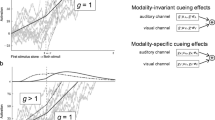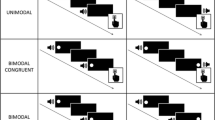Abstract
When auditory stimuli are used in two-dimensional spatial compatibility tasks, where the stimulus and response configurations vary along the horizontal and vertical dimensions simultaneously, a right–left prevalence effect occurs in which horizontal compatibility dominates over vertical compatibility. The right–left prevalence effects obtained with auditory stimuli are typically larger than that obtained with visual stimuli even though less attention should be demanded from the horizontal dimension in auditory processing. In the present study, we examined whether auditory or visual dominance occurs when the two-dimensional stimuli are audiovisual, as well as whether there will be cross-modal facilitation of response selection for the horizontal and vertical dimensions. We also examined whether there is an additional benefit of adding a pitch dimension to the auditory stimulus to facilitate vertical coding through use of the spatial-musical association of response codes (SMARC) effect, where pitch is coded in terms of height in space. In Experiment 1, we found a larger right–left prevalence effect for unimodal auditory than visual stimuli. Neutral, non-pitch coded, audiovisual stimuli did not result in cross-modal facilitation, but did show evidence of visual dominance. The right–left prevalence effect was eliminated in the presence of SMARC audiovisual stimuli, but the effect influenced horizontal rather than vertical coding. Experiment 2 showed that the influence of the pitch dimension was not in terms of influencing response selection on a trial-to-trial basis, but in terms of altering the salience of the task environment. Taken together, these findings indicate that in the absence of salient vertical cues, auditory and audiovisual stimuli tend to be coded along the horizontal dimension and vision tends to dominate audition in this two-dimensional spatial stimulus–response task.




Similar content being viewed by others
References
Chan, C. W. L., & Chan, A. H. S. (2005). Spatial S–R compatibility of visual and auditory signals: implications for human-machine interface design. Displays, 26, 109–119.
Colavita, F. B. (1974). Human sensory dominance. Perception and Psychophysics, 16, 409–412.
Eimer, M., & Schröger, E. (1998). ERP effects of intermodal attention and cross-modal links in spatial attention. Psychophysiology, 35, 313–327.
Haas, E., & Edworthy, J. (2006). An introduction to auditory warnings and alarms. In M. S. Wogalter (Ed.), Handbook of warnings (pp. 189–198). Mahwah: Erlbaum.
Heister, G., Ehrenstein, W. H., & Schroeder-Heister, P. (1986). Spatial SR compatibility effects with unimanual two-finger choice reactions for prone and supine hand positions. Perception and Psychophysics, 40(4), 271–278.
Hommel, B. (1996). No prevalence of right–left over top–bottom spatial codes. Perception and Psychophysics, 43, 102–110.
Keller, P. E., & Koch, I. (2006). Exogenous and endogenous response priming with auditory stimuli. Advances in Cognitive Psychology, 2(4), 269–276.
Lee, F. C. H., & Chan, A. H. S. (2007). Attending visual and auditory signals: ergonomics recommendations with consideration of signal modality and spatial stimulus–response (S–R) compatibility. International Journal of Industrial Ergonomics, 37, 197–206.
Lidji, P., Kolinsky, R., Lochy, A., & Morais, J. (2007). Spatial associations for musical stimuli: a piano in the head? Journal of Experimental Psychology: Human Perception and Performance, 33, 1189–1207.
Meredith, M. A., & Stein, B. E. (1986). Visual, auditory, and somatosensory convergence on cells in the superior colliculus results in multisensory integration. Journal of Neurophysiology, 56, 640–662.
Ngo, M. K., Sinnett, S., Soto-Faraco, S., & Spence, C. (2010). Repetition blindness and the Colavita effect. Neuroscience Letters, 480, 186–190.
Nicoletti, R., & Umiltà, C. (1984). Right–left prevalence in spatial compatibility. Perception and Psychophysics, 35, 333–343.
Nicoletti, R., & Umiltà, C. (1985). Responding with hand and foot: the right/left prevalence in spatial compatibility is still present. Perception and Psychophysics, 38, 211–216.
Nicoletti, R., Umiltà, C., Tressoldi, E. P., & Marzi, C. A. (1988). Why are right–left spatial codes easier to form than above-below ones? Perception and Psychophysics, 43, 287–292.
Nishimura, A., & Yokosawa, K. (2009). Effects of laterality and pitch height of an auditory accessory stimulus on horizontal response selection: the Simon effect and the SMARC effect. Psychonomic Bulletin and Review, 16, 666–670.
Perrott, D. R., & Saberi, K. (1990). Minimum audible angle thresholds for sources varying in both elevation and azimuth. The Journal of the Acoustical Society of America, 87, 1728.
Proctor, R. W., & Vu, K.-P. L. (2006). Stimulus-response compatibility principles: data theory and application. Boca Raton: CRC Press.
Rubichi, S., Vu, K.-P. L., Nicoletti, R., & Proctor, R. W. (2006). Spatial coding in two dimensions. Psychonomic Bulletin and Review, 13, 201–216.
Rusconi, E., Kwana, B., Giordano, B. L., Umiltà, C., & Butterworth, B. (2006). Spatial representation of pitch height: the SMARC effect. Cognition, 99, 113–129.
Santagelo, V., & Spence, C. (2008). Capturing spatial attention with multisensory cues. Psychonomic Bulletin and Review, 15, 398–403.
Scharf, B. (1998). Auditory attention: the psychoacoustical approach. In H. Pashler (Ed.), Attention (pp. 75–118). East Sussex: Psychology Press.
Sinnett, S., Spence, C., & Soto-Faraco, S. (2007). Visual dominance and attention: the Colavita effect revisited. Perception and Psychophysics, 69, 673–686.
Vu, K.-P. L., & Proctor, R. W. (2001). Determinants of right–left and top-bottom prevalence for two-dimensional spatial compatibility. Journal of Experimental Psychology: Human Perception and Performance, 27, 813–828.
Vu, K.-P. L., & Proctor, R. W. (2002). The prevalence effect in two-dimensional stimulus-response compatibility as a function of the relative salience of the dimensions. Perception and Psychophysics, 64, 815–828.
Vu, K.-P. L., Proctor, R. W., & Pick, D. F. (2000). Horizontal versus vertical compatibility: right–left prevalence with bimanual responses. Psychological Research, 64, 25–40.
Welch, R. B., & Warren, D. H. (1980). Immediate perceptual response to intersensory discrepancy. Psychological Bulletin, 88, 638.
Author information
Authors and Affiliations
Corresponding author
Rights and permissions
About this article
Cite this article
Vu, KP.L., Minakata, K. & Ngo, M.K. Influence of auditory and audiovisual stimuli on the right–left prevalence effect. Psychological Research 78, 400–410 (2014). https://doi.org/10.1007/s00426-013-0518-4
Received:
Accepted:
Published:
Issue Date:
DOI: https://doi.org/10.1007/s00426-013-0518-4




